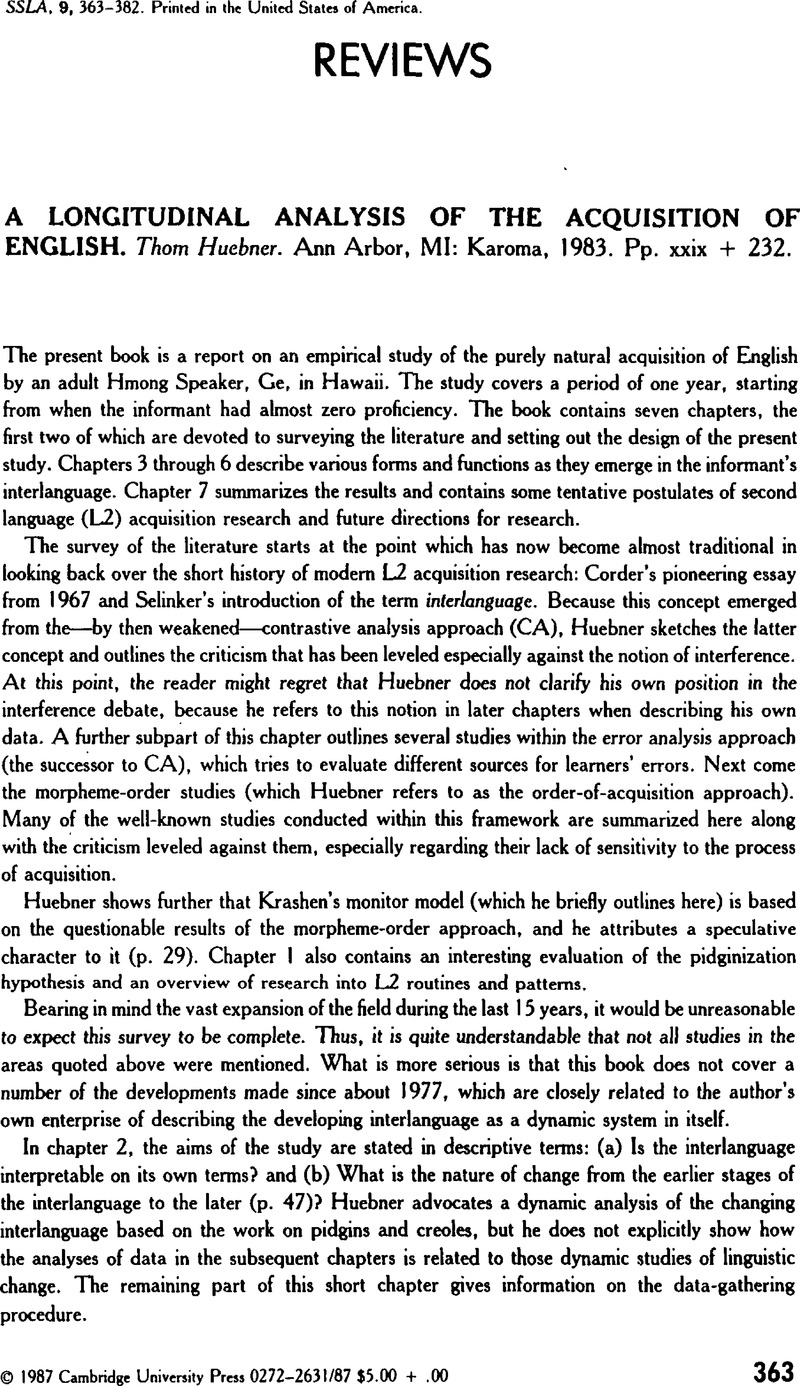No CrossRef data available.
Article contents
A LONGITUDINAL ANALYSIS OF THE ACQUISITION OF ENGLISH. Thom Huebner. Ann Arbor, MI: Karoma, 1983. Pp. xxix + 232.
Review products
A LONGITUDINAL ANALYSIS OF THE ACQUISITION OF ENGLISH. Thom Huebner. Ann Arbor, MI: Karoma, 1983. Pp. xxix + 232.
Published online by Cambridge University Press: 07 November 2008
Abstract
An abstract is not available for this content so a preview has been provided. Please use the Get access link above for information on how to access this content.

- Type
- Reviews
- Information
- Copyright
- Copyright © Cambridge University Press 1987
References
REFERENCES
Bailey, C.-J. (1973). Variation and linguistic theory. Arlington, VA: Center for Applied Linguistics.Google Scholar
Bickerton, D. (1971). Inherent variability and variable rules. Foundations of Language, 7, 457–492.Google Scholar
Cazden, C., Cancino, H., Rosansky, E., & Schumann, J. (1975). Second language acquisition sequences in children, adolescents and adults (Research Report). Cambridge, MA: Harvard University Graduate School of Education.Google Scholar
Clahsen, H., Meisel, J., & Pienemann, M. (1983). Deutsch als Zweitsprache. Tübingen: Gunter Narr.Google Scholar
DeCamp, D. (1973). Implicational scales and sociolinguistic linearity. Linguistics, 73, 30–43.Google Scholar
Felix, S. W. (Ed.). (1980). Second language development: Trends and issues. Tübingen: Gunter Narr.Google Scholar
Huebner, T. (1979). Order-of-acquisition versus dynamic paradigm: A comparison of method in interlanguage research. TESOL Quarterly, 13, 21–28.CrossRefGoogle Scholar
Hyltenstam, K. (1977). Implication patterns in interlanguage syntax variation. Language Learning, 27, 383–411.CrossRefGoogle Scholar
Klein, W., & Dittmar, H. (1979). Developing grammars: The acquisition of German syntax by foreign workers. Berlin: Springer.CrossRefGoogle Scholar
Labov, W. (1969). Contraction, deletion and inherent variability of the English copula. Language, 45, 715–762.CrossRefGoogle Scholar
Levelt, W., Mills, A., & Karmiloff-Smith, A. (1981). Child language research in ESF countries: An inventory. Strasbourg: European Science Foundation.Google Scholar
Li, C., & Thompson, S. (1976). Subject and topic: A new typology of language. In Li, C. (Ed.), Subject and topic, (pp. 457–490). New York: Academic.Google Scholar
Meisel, J., Clahsen, H., & Pienemann, M. (1981). On determining developmental stages in second language acquisition. Studies in Second Language Acquisition, 3, 109–135.CrossRefGoogle Scholar
Nicholas, H., & Meisel, J. (1983). Second language acquisition: The state of the art. In Felix, S. & Wode, H. (Eds.), Language development at the crossroads (pp. 63–90). Tübingen: Gunter Narr.Google Scholar
Pienemann, M. (1981). Der Zweitspracherwerb ausländischer Arbeiterkinder. Bonn: Bouvier.Google Scholar
Wode, H. (1981). Learning a second language: Vol. 1. An integrated view of language acquisition. Tübingen: Gunter Narr.Google Scholar


